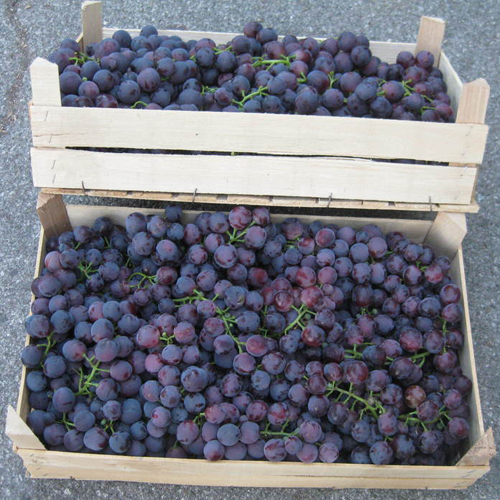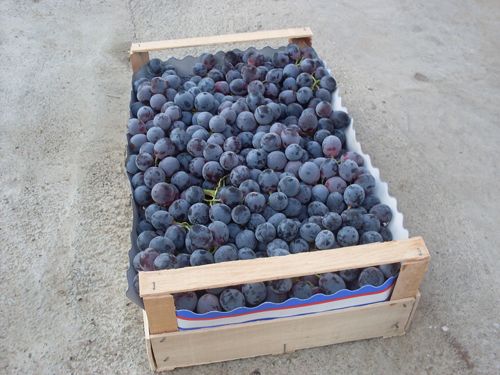Cardinal grape variety
Cardinal is a famous and most popular, especially abroad, table grape variety, which was born back in 1939 at the California field gardening station in Fresno. The authors of this masterpiece were E. Snyder and F. Harmon, who crossed, as they assumed, a variety of Algerian origin Flame Tokay with French Alphonse Lavalle. These varieties were considered the parents of Kadinal for almost seventy years, until DNA research reliably established that he did not have Flame Tokai genes, after which the Queen of the Vineyards was officially recognized as the maternal form.

During its relatively long life for table grapes, Cardinal has gained popularity on many continents. It is still actively cultivated in the USA, Italy, France, Spain, Morocco, Turkey, Greece, Romania, Bulgaria, the former Yugoslav republics and other countries. In Southeast Asia, and in particular in Vietnam and Thailand, it is widely used as a technical grape for wine production. It first appeared in the Soviet Union in 1958, when it was brought into the ampelographic collection of the Moldavian Research Institute of Viticulture and Winemaking from a French nursery located in the city of Montpellier. In 1965, an application was submitted for a variety trial of Cardinal, which was successfully completed by 1974, after which it was zoned in the southern regions and republics of the country. Currently, the variety is officially included in Russia in the state register of selection achievements and admitted to industrial cultivation in the North Caucasus (Republic of Crimea, North Ossetia-Alania, Dagestan, Kabardino-Balkarian, Adygea, Ingushetia, Chechen, Rostov region, Krasnodar and Stavropol Territories ) and Nizhnevolzhsky (Saratov, Astrakhan, Volgograd regions and the Republic of Kalmykia) regions.
Special mention should be made of the attitude towards the Cardinal of amateur winegrowers. In particular, it must be admitted that the peak of its distribution among domestic amateurs has already passed. The areas occupied by this grape for many years are inexorably decreasing, and in new plantings, preference is given to new, more unpretentious and easy-to-cultivate varieties of sun berries.
At the same time, one cannot fail to note the unquenchable demand that Cardinal still demonstrates in breeding work. Every year, with his participation, many promising hybrid forms appear, which he endows with genes for early maturity, large-fruited, excellent taste and aroma. To maintain his once fantastic popularity, he himself lacks any serious resistance to diseases, the ability to tolerate unfavorable growing conditions, stability of fruiting and general simplicity. All these missing qualities are successfully borrowed by breeders from the second half of the parental couples, and as a result, the numerous and diverse offspring of the Cardinal, while maintaining the invariably high quality of the fruits, receive everything that he himself lacks for less troublesome cultivation.

Agrobiological characteristics of the variety
Grape bushes are medium-sized. The crown of a young shoot is light green, not pubescent, with a slightly bronze tint along the edge of young leaves. The leaves are large, rounded, five-lobed, have an average degree of dissection. The surface of the leaf is smooth, sometimes wavy, with a metallic sheen, the pubescence of the dorsum is absent. The upper notches are quite deep, closed with an oval opening, or open slit-like, the lower ones are of shallow depth, open lyre-shaped with a narrow aperture, or in the form of a reentrant angle. The petiole notch is open, vaulted, of medium width. The denticles along the edge of the leaf blade are triangular or saw-shaped, with convex sides (domed). The flowers are bisexual, pollinated satisfactorily.In years with unfavorable weather conditions during flowering, clusters are distinguished by a significant degree of pea. The ripening of the Cardinal's shoots is also satisfactory. Ripe annual vines are light brown in color with darker areas in the area of nodes.
The bunches of this variety, with good care, are quite large, their length can reach 28 cm, width - 18 cm, the average weight is 350-500 grams, but some grow to almost a kilogram. The shape of the bunches of grapes is usually cylindrical-conical; in terms of density, they are friable and even very friable. The comb is long (up to 8 cm), light green, fragile. Berries are large (21-29 mm long and 18-23 mm wide), rounded or slightly oval, may have a beveled top and a weak groove on its surface, with an average weight of 6-7 grams. In some years, grapes within a bunch can vary significantly in size. The pulp of the Cardinal berries has a fleshy-juicy consistency, slightly crispy, white-green in color, with a pleasant harmonious taste and a subtle delicate aroma of nutmeg. The juice is colorless, its sugar content reaches 18 grams / 100 cubic meters. cm, acidity fluctuates at the level of 7-8.5 grams / liter. The skin is of moderate density, strong enough and at the same time edible. It is painted on the outside in a violet-red color and covered with a smoky bloom of pruin. The seeds are quite large, usually from two to four, but they do not have an excessively negative effect on the taste of a large berry. Grape tasting score - 8-9 points.

The crop is used mainly for fresh consumption, but is often used in home canning as a raw material for delicious compotes and jam in taste, aroma and appearance. In some countries, it is even used to make wine. The presentation of grapes with a competent approach to cultivation is quite high, many buyers remember and love this variety, excellent in taste, and therefore willingly purchase it. Cardinal shows itself perfectly during long-distance transportation and is more than well-stored (under optimal conditions - up to three months from the date of collection).
Bunches ripen very early, in the south, in traditional growing regions, in early August. For the onset of removable ripeness from the time of bud break, 120 days and the sum of active temperatures - 2250-2350 ° C are enough. Due to the short growing season, the variety can be cultivated a little to the north of the zoned regions, provided, of course, high-quality shelter of grape vines for the winter. By the way, the Cardinal does not shine with frost resistance, and therefore requires shelter, at least light, even in the relatively mild climate of the North Caucasus.
The productivity of plants is quite high. The number of fruiting shoots is 60-70%, the average number of clusters per developed shoot is 0.9, and per fruitful is 1.3. The yield of the Cardinal is potentially high, but variable, and depends on a number of factors, from a favorable overwintering to the conditions of flowering, berry growth and ripening. On average, with a sufficiently high level of agricultural technology, high-quality and scrupulous performance of all the necessary operations in the vineyard, effective control of pests and diseases, it is quite possible to grow from a hectare of plantations to one hundred or even more centners of high-quality fruits. Individual farms have enough evidence of 10-20 kilograms of grapes from a bush. At the same time, the variety reacts very painfully to overload, and even a single miscalculation of this kind can lead to a strong weakening of the plant and its death in winter.

The crop can hang on the bush for some time after ripening, but it must be borne in mind that the berries often crack when heavy rains fall or active watering. In addition, they are susceptible to rot damage and damage from leaf rollers, which must be taken into account when organizing the fight against fungal diseases and pests.
Agrotechnical features
In cultivation, Cardinal shows itself as a very capricious variety, in order to obtain a high and high-quality harvest of which it is necessary to apply the remarkable talent of the winegrower and pedantry in performing all the necessary operations in the vineyard.
Plants, despite the relatively small amount of required active temperatures, are quite thermophilic, and therefore prefer planting on slopes with a southern or southwestern exposure. In amateur plantings, in relatively northern regions that are not traditional for viticulture, it must be planted under protection from cold winds from the south side of the house, fence, walls of any other buildings. In soils, grapes prefer and grow better on fertile chernozems with an average mechanical composition: they do not tolerate either excessively heavy or sandy dry soils, preferring light loams or sandy loams. The variety is propagated and planted, as a rule, in a grafted culture, especially in the regions where phylloxera is spread. The best stock is considered Berlandieri x Riparia CO4, and on soils with a significant carbonate content - Chassela x Berlandieri 41 B.
Almost everywhere, in moderate climatic conditions, Cardinal is grown with shelter for the winter due to the low frost resistance of the vine. In order to be able to do this efficiently, even at the stage of forming a grape bush, it is necessary to take care of giving it a shape that is convenient for the subsequent annual removal of vines from the trellis. For this, options are suitable according to the scheme of a two-armed Guyot, a standard fan or an inclined cordon. Protection is carried out with the utmost care and an objective assessment of the frost hazard of the climate. If in the south there are enough light single-layer shelters, then in colder regions you will have to work hard on a powerful multilayer protection of the bushes. Straw, sawdust, reed mats and even dry fallen leaves of tree species are used as insulating material. On top of the shelter, boxes or shields are installed to prevent getting wet, or they are covered with a protective layer with roofing material or film.
Only in a very mild subtropical climate is it possible, without the risk of frost damage to the bushes, to form a variety on a high trunk without shelter for the winter. This arrangement, among other things, is favorable for the Cardinal to accumulate a large volume of perennial wood, which is very positive for the size of the bunches and the overall yield of the grapes.
Fruiting bushes are loaded very moderately. With spring pruning, only 25-30 eyes should remain on the plant, of which no more than 13-16 fruitful shoots will develop during the growing season. Excess shoots are ruthlessly removed during the wreckage, since an overloaded bush will not only yield a low-quality crop, but will also lose that vital energy that is so necessary for it to go through the winter period. The pruning length can be quite short (3-4 eyes), due to the good fruitfulness of the lower buds of the grapes.
It is very conscientious to treat the protection of the Cardinal from pests and diseases. It demonstrates weak resistance to almost all of them, which requires an integrated comprehensive approach to the implementation of its treatment with approved chemicals according to standard protocols for the protection of varieties susceptible to pathogens. In this case, the number of treatments per growing season can reach nine.
To improve fertilization of flowers and prevent possible pea berries, it is recommended to additionally pollinate grape inflorescences with puffs. Cracking of ripening berries can be prevented by competently regulating the water balance of the soil with moderate watering, avoiding sudden changes in its moisture.
In general, the Cardinal can be called the brainchild of his time.Once, in terms of the quality of the fruits, he had no equal, and therefore, they simply turned a blind eye to the existing difficulties in agricultural technology. Today, when at the disposal of winegrowers there are many new high-quality hybrids, much more unpretentious in cultivation, we have to state with regret that the era of our hero is leaving. Only the most devoted fans of the variety continue to cultivate it no matter what, and breeders perpetuate its name, creating with its participation more and more varieties of high-quality grapes.








